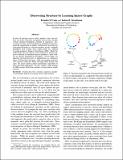Discovering Structure by Learning Sparse Graphs
Author(s)
Lake, Brenden M; Tenenbaum, Joshua B
DownloadLakeTenenbaum2010CogSci.pdf (653.0Kb)
OPEN_ACCESS_POLICY
Open Access Policy
Creative Commons Attribution-Noncommercial-Share Alike
Terms of use
Metadata
Show full item recordAbstract
Systems of concepts such as colors, animals, cities, and artifacts are richly structured, and people discover the structure of these domains throughout a lifetime of experience. Discovering structure can be formalized as probabilistic inference about the organization of entities, and previous work has operationalized learning as selection amongst specific candidate
hypotheses such as rings, trees, chains, grids, etc. defined by graph grammars (Kemp & Tenenbaum, 2008). While this model makes discrete choices from a limited set, humans appear to entertain an unlimited range of hypotheses, many without an obvious grammatical description. In this paper, we approach structure discovery as optimization in a continuous space of all possible structures, while encouraging structures to be sparsely connected. When reasoning about animals and cities, the sparse model achieves performance equivalent to more structured approaches. We also explore a large domain of 1000 concepts with broad semantic coverage and no simple structure.
Date issued
2010-08Department
Massachusetts Institute of Technology. Department of Brain and Cognitive SciencesJournal
Proceedings of 32nd Annual Meeting of the Cognitive Science Society (CogSci 2010)
Publisher
Cognitive Science Society, Inc.
Citation
Lake, Brendan and Joshua Tenenbaum."Discovering Structure by Learning Sparse Graphs." Proceedings of the 32nd Annual Meeting of the Cognitive Science Society CogSci 2010, Portland, Oregon, United States, 11-14 August, 2010, Cognitive Science Society, Inc., 2010. pp. 778-784.
Version: Author's final manuscript
ISBN
978-1-61738-890-3